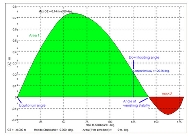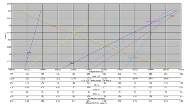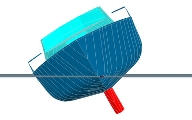STUART ROY - NAVAL ARCHITECT
Fellow of the Royal Institution of Naval Architects & Chartered Engineer
Yachts and boats are routinely assessed for their stability characteristics so that it can be demonstrated that they comply with the relevant regulations, such as the MCA Codes of Practice applying to a craft used for commercial purposes. The data generated during the stability assessment would normally be compiled by a Naval Architect into a document known as a Stability Information Booklet (SIB). The layout of this is generally in a standard form, prescribed by the regulatory authority.
Using computer-generated hull models and the Maxsurf Stability analysis program, I have compiled numerous Stability Booklets for both new and existing vessels, to the extent that this work has become one of my specialities. Where the design data for the boat is available in electronic form (as in most new designs) the process is very much quicker than having to work from printed drawings, or having to take the lines from an existing vessel. At some stage in the process almost all vessels will need to have a small angle inclining test carried out and the results included in the SIB.
Once an accurate hull model has been created and non-buoyant volumes such as bow thruster included, the tanks are defined (1) and calibrated so that their free surface effects can be included in the stability analysis. For sailing vessels the superstructure is also defined (2) so that its buoyancy is taken into account when the computer model is subjected to simulated heeling through 180 degrees.
The hydrostatic curves (3) for the vessel are generated for the full range of trim angles likely to be experienced by the vessel. For each of the expected Loading Conditions, including Departure with 100% consumables aboard, and Arrival with just 10% aboard, the vessel is inclined (4 and 5) through the full range of heel angles to produce righting lever or GZ curves for the vessel (6). For each Loading Condition, the important features of the GZ curve, such as the downflooding angle, angle of vanishing stability and positive area, are then checked and evaluated against the criteria stated in the Regulations or MCA Code.
When a vessel is likely to carry more than a few people and/or make ocean passages, damage survivability is also investigated by simulating the effect of flooding (7) each watertight compartment in turn. Even with a compartment in a damaged state the vessel is still expected to maintain some freeboard and transverse stability, sufficient to enable the craft to stay afloat and allow the people to be taken off.
If the vessel passes all the requirements of the Code or Regulation, the vessel will gain certification from a Certifying Authority. A copy of the Stability Information Booklet, with approval stamp, then remains on the vessel for use by the Master.
Using computer-
Once an accurate hull model has been created and non-
The hydrostatic curves (3) for the vessel are generated for the full range of trim angles likely to be experienced by the vessel. For each of the expected Loading Conditions, including Departure with 100% consumables aboard, and Arrival with just 10% aboard, the vessel is inclined (4 and 5) through the full range of heel angles to produce righting lever or GZ curves for the vessel (6). For each Loading Condition, the important features of the GZ curve, such as the downflooding angle, angle of vanishing stability and positive area, are then checked and evaluated against the criteria stated in the Regulations or MCA Code.
When a vessel is likely to carry more than a few people and/or make ocean passages, damage survivability is also investigated by simulating the effect of flooding (7) each watertight compartment in turn. Even with a compartment in a damaged state the vessel is still expected to maintain some freeboard and transverse stability, sufficient to enable the craft to stay afloat and allow the people to be taken off.
If the vessel passes all the requirements of the Code or Regulation, the vessel will gain certification from a Certifying Authority. A copy of the Stability Information Booklet, with approval stamp, then remains on the vessel for use by the Master.





1
2
3
7


4
6
5
Stability Booklets for MCA Codes
Intact and Damaged Stability Assessment